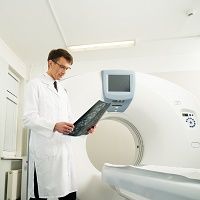Ultralow-Dose CT Scan Potentially as Effective as Standard-Dose Scan for Some COPD Patients
New research shows that ultralow-dose CT scans may be a viable means of diagnosing COPD. The study compared results of the ultralow-dose tests alongside those of standard CT tests.

Chronic obstructive pulmonary disease (COPD) patients may be able to be diagnosed using ultralow-dose CT (ULDCT) scans instead of standard-dose CT (SDCT) scans in some cases, according to findings published in the American Journal of Roentgenology.
Researchers from Kobe University in Japan retrospectively observed 50 emphysema patients in order to evaluate the agreement between SDCT and ULDCT findings in these patients. The patients underwent one of the two tests and the researchers also collected data about low attenuation volume percentage in the lungs at four thresholds, mean lung attenuation, and total lung volume. The analysts then calculated the concordance correlation coefficients to assess the agreement of emphysema quantification between the two types of CT scans.
The study authors reported that ULDCT scans could, with and without iterative reconstruction, substitute for SDCT in emphysema quantification. They added that the low attenuation volume percentage concordance correlation coefficients were between 0.310 and 0.789 between SDCT scans and ULDCT scans without iterative reconstruction; with iterative reconstruction, that coefficient was between 0.934 and 0.966.
“Although further studies are needed to validate the usefulness of emphysema quantification with ULDCT scans, we expect that emphysema quantification can be reliably performed with ULDCT scans both without and with iterative reconstruction to stratify lung cancer risk and reduce the radiation dose associated with CT screening for lung cancer,” lead author Dr. Mizuho Nishio said in a press release.
Plus, the researchers reported, the agreement of the lung volume percentage improved with iterative reconstruction was used in ULDCT scans. The average lung attenuation concordance correlation coefficient value between SDCT and ultra ULDCT scans without iterative reconstruction was substantial, at 0.957, while the coefficient between the CT scan types with iterative reconstruction was poor, at 0.890. The researchers called the lung volume concordance correlation coefficient “substantial” with and without iterative reconstruction (0.982 and 0.983, respectively).
“Given the tradeoff between image quality and radiation dose in CT, excessive dose reduction can interfere with the interpretation and analysis of CT images,” Nishio concluded.